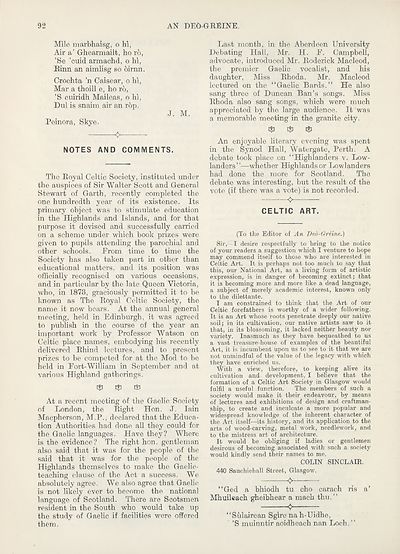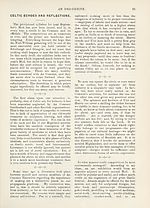An Comunn Gàidhealach Publications > Deo-gréine > Volume 17, October 1921 to September 1922
(100) Page 92
Download files
Complete book:
Individual page:
Thumbnail gallery: Grid view | List view

AN DEO-GREINE.
Mile marbhaisg, o hi,
Air a’ Ghearmailt, ho ro,
’Se ’cuid armachd, o hi,
Rinn an aimlisg so 6irnn.
Crochta ’n Caisear, o hi,
Mar a thoill e, ho ro,
’S cuiridh Maileas, o hi,
Dul is snaim air an r6p.
J. M.
Peinora, Skye.
0
NOTES AND COMMENTS.
The Royal Celtic Society, instituted under
the auspices of Sir Walter Scott and General
Stewart of Garth, recently completed the
one hundredth year of its existence. Its
primary object was to stimulate education
in the Highlands and Islands, and for that
purpose it devised and successfully carried
on a scheme under which book prizes were
given to pupils attending the parochial and
other schools. From time to time the
Society has also taken part in other than
educational matters, and its position was
officially recognised on various occasions,
and in particular by the late Queen Victoria,
who, in 1873, graciously permitted it to be
known as The Royal Celtic Society, the
name it now bears. At the annual general
meeting, held in Edinburgh, it was agreed
to publish in the course of the year an
important work by Professor Watson on
Celtic place names, embodying his recently
delivered Rhind lectures, and to present
prizes to be competed for at the Mod to be
held in Fort-William in September and at
various Highland gatherings.
$1 t$3 ts
At a recent meeting of the Gaelic Society
of London, the Right Hon. J. Iain
Macpherson, M.P., declared that the Educa¬
tion Authorities had done all they could for
the Gaelic languages. Have they? Where
is the evidence? The right hon. gentleman
also said that it was for the people of the
said that it was for the people of the
Highlands themselves to make the Gaelic-
teaching clause of the Act a success. We
absolutely agree. We also agree that Gaelic
is not likely ever to become the national
language of Scotland. There are Scotsmen
resident in the South who would take up
the study of Gaelic if facilities were offered
them.
Last month, in the Aberdeen University
Debating Hall, Mr. H. F. Campbell,
advocate, introduced Mr. Roderick Macleod,
the premier Gaelic vocalist, and his
daughter, Miss Rhoda. Mr. Macleod
lectured on the “Gaelic Bards.” He also
sang three of Duncan Ban’s songs. Miss
Rhoda also sang songs, which were much
appreciated by the large audience. It was
a memorable meeting in the granite city,
cfc t$J cfc
An enjoyable literary evening was spent
in the Synod Hall, Watergate, Perth. A
debate took place on “Highlanders v. Low-
landers”—whether Highlands or Lowlanders
had done the more for Scotland. The
debate was interesting, but the result of the
vote (if there was a vote) is not recorded.
0
CELTIC ART.
(To the Editor of An Ded-Griine.)
Sir,—I desire respectfully to bring to the notice
of your readers a suggestion which I venture to hope
may commend itself to those who are interested in
Celtic Art. It is perhaps not too much to say that
this, our National Art, as a living form of artistic
expression, is in danger of becoming extinct; that
it is becoming more and more like a dead language,
a subject of merely academic interest, known only
to the dilettante.
I am constrained to think that the Art of our
Celtic forefathers is worthy of a wider following.
It is an Art whose roots penetrate deeply our native
soil; in its cultivation, our native artists saw to it
that, in its blossoming, it lacked neither beauty nor
variety. Inasmuch as they have bequeathed to us
a vast treasure-house of examples of the beautiful
Art, it is incumbent upon us to see to it that we are
not unmindful of the value of the legacy with which
they have enriched us.
With a view, therefore, to keeping alive its
cultivation and development, I believe that the
formation of a Celtic Art Society in Glasgow would
fulfil a useful function. The members of such a
society would make it their endeavour, by means
of lectures and exhibitions of design and craftman-
ship, to create and inculcate a more popular and
widespread knowledge of the inherent character of
the Art itself—its history, and its application to the
arts of wood-carving, metal work, needlework, and
to the mistress art of architecture.
It would be obliging if ladies or gentlemen
desirous of becoming associated with such a society
would kindly send their names to me.
COLIN SINCLAIR.
440 Sauchiehall Street, Glasgow.
“Ged a bhiodh tu cho carach ris a’
Mhuileach gheibhear a maeh thu.”
0
“Sulairean Sglre na h-Uidhe,
’S muinntir aoidheach nan Loch. ’ ’
Mile marbhaisg, o hi,
Air a’ Ghearmailt, ho ro,
’Se ’cuid armachd, o hi,
Rinn an aimlisg so 6irnn.
Crochta ’n Caisear, o hi,
Mar a thoill e, ho ro,
’S cuiridh Maileas, o hi,
Dul is snaim air an r6p.
J. M.
Peinora, Skye.
0
NOTES AND COMMENTS.
The Royal Celtic Society, instituted under
the auspices of Sir Walter Scott and General
Stewart of Garth, recently completed the
one hundredth year of its existence. Its
primary object was to stimulate education
in the Highlands and Islands, and for that
purpose it devised and successfully carried
on a scheme under which book prizes were
given to pupils attending the parochial and
other schools. From time to time the
Society has also taken part in other than
educational matters, and its position was
officially recognised on various occasions,
and in particular by the late Queen Victoria,
who, in 1873, graciously permitted it to be
known as The Royal Celtic Society, the
name it now bears. At the annual general
meeting, held in Edinburgh, it was agreed
to publish in the course of the year an
important work by Professor Watson on
Celtic place names, embodying his recently
delivered Rhind lectures, and to present
prizes to be competed for at the Mod to be
held in Fort-William in September and at
various Highland gatherings.
$1 t$3 ts
At a recent meeting of the Gaelic Society
of London, the Right Hon. J. Iain
Macpherson, M.P., declared that the Educa¬
tion Authorities had done all they could for
the Gaelic languages. Have they? Where
is the evidence? The right hon. gentleman
also said that it was for the people of the
said that it was for the people of the
Highlands themselves to make the Gaelic-
teaching clause of the Act a success. We
absolutely agree. We also agree that Gaelic
is not likely ever to become the national
language of Scotland. There are Scotsmen
resident in the South who would take up
the study of Gaelic if facilities were offered
them.
Last month, in the Aberdeen University
Debating Hall, Mr. H. F. Campbell,
advocate, introduced Mr. Roderick Macleod,
the premier Gaelic vocalist, and his
daughter, Miss Rhoda. Mr. Macleod
lectured on the “Gaelic Bards.” He also
sang three of Duncan Ban’s songs. Miss
Rhoda also sang songs, which were much
appreciated by the large audience. It was
a memorable meeting in the granite city,
cfc t$J cfc
An enjoyable literary evening was spent
in the Synod Hall, Watergate, Perth. A
debate took place on “Highlanders v. Low-
landers”—whether Highlands or Lowlanders
had done the more for Scotland. The
debate was interesting, but the result of the
vote (if there was a vote) is not recorded.
0
CELTIC ART.
(To the Editor of An Ded-Griine.)
Sir,—I desire respectfully to bring to the notice
of your readers a suggestion which I venture to hope
may commend itself to those who are interested in
Celtic Art. It is perhaps not too much to say that
this, our National Art, as a living form of artistic
expression, is in danger of becoming extinct; that
it is becoming more and more like a dead language,
a subject of merely academic interest, known only
to the dilettante.
I am constrained to think that the Art of our
Celtic forefathers is worthy of a wider following.
It is an Art whose roots penetrate deeply our native
soil; in its cultivation, our native artists saw to it
that, in its blossoming, it lacked neither beauty nor
variety. Inasmuch as they have bequeathed to us
a vast treasure-house of examples of the beautiful
Art, it is incumbent upon us to see to it that we are
not unmindful of the value of the legacy with which
they have enriched us.
With a view, therefore, to keeping alive its
cultivation and development, I believe that the
formation of a Celtic Art Society in Glasgow would
fulfil a useful function. The members of such a
society would make it their endeavour, by means
of lectures and exhibitions of design and craftman-
ship, to create and inculcate a more popular and
widespread knowledge of the inherent character of
the Art itself—its history, and its application to the
arts of wood-carving, metal work, needlework, and
to the mistress art of architecture.
It would be obliging if ladies or gentlemen
desirous of becoming associated with such a society
would kindly send their names to me.
COLIN SINCLAIR.
440 Sauchiehall Street, Glasgow.
“Ged a bhiodh tu cho carach ris a’
Mhuileach gheibhear a maeh thu.”
0
“Sulairean Sglre na h-Uidhe,
’S muinntir aoidheach nan Loch. ’ ’
Set display mode to:
![]() Universal Viewer |
Universal Viewer | ![]() Mirador |
Large image | Transcription
Mirador |
Large image | Transcription
| An Comunn Gàidhealach > An Comunn Gàidhealach Publications > Deo-gréine > Volume 17, October 1921 to September 1922 > (100) Page 92 |
|---|
| Permanent URL | https://digital.nls.uk/127171173 |
|---|
| Description | Leabhar 17, Treasamh Mios an Fhoghair 1921 gu Dara Mìos an Fhoghair 1922 |
|---|---|
| Attribution and copyright: |
|
| Description | This contains items published by An Comunn, which are not specifically Mòd-related. It includes journals, annual reports and corporate documents, policy statements, educational resources and published plays and literature. It is arranged alphabetically by title. |
|---|
| Description | A collection of over 400 items published by An Comunn Gàidhealach, the organisation which promotes Gaelic language and culture and organises the Royal National Mòd. Dating from 1891 up to the present day, the collection includes journals and newspapers, annual reports, educational materials, national Mòd programmes, published Mòd literature and music. |
|---|---|
| Additional NLS resources: |
|

